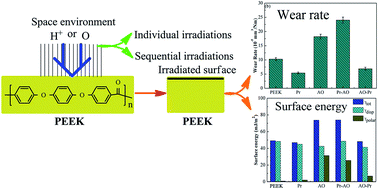Abstract: The changes in the surface structure and the tribological performance of polyetheretherketone (PEEK) induced by individual and sequential irradiations with atomic oxygen (AO) and protons (Prs) were investigated in a space environment simulation facility. The experimental results showed that Pr irradiation induced the surface carbonization of PEEK which induced the greatest degree of decrease in the surface roughness from 29.61 nm to 16.15 nm, surface energy from 49.16 mJ m(-2) to 46.96 mJ m(-2), friction coefficient from 0.28 to 0.08 and wear rate from 10.28 x 10 (5) mm(3) N (1) m (1) to 5.45 x 10 (5) mm(3) N-1 m(-1). The AO irradiation induced the surface oxidation of PEEK, and then increased the surface roughness from 29.61 nm to 58.77 nm, surface energy from 49.16 mJ m(-2) to 73.75 mJ m(-2), friction coefficient from 0.28 to 0.35 and wear rate from 10.28 x 10(-5) mm(3) N-1 m(-1) to 18.22 x 10(-5) mm(3) N-1 m(-1). The surface structural variations and tribological performance of PEEK induced by the sequential Pr-AO and AO-Pr irradiations were respectively similar to the results of the individual AO and Pr irradiations, and the final form of irradiation has a bigger effect on the changes in the surface structure and tribological performance during the sequential irradiation tests. The erosion stacking effect of the sequential irradiations was observed, and the AO-Pr irradiations caused the biggest changes in infrared spectra and the surface composition of C and O elements in X-ray photoelectron spectroscopy. The Pr-AO irradiations gave the biggest increment in the surface energy from 49.16 mJ m(-2) to 74.03 mJ m(-2) and wear rate from 10.28 x 10(-5) mm(3) N-1 m(-1) to 24.07 x 10(-5) mm(3) N-1 m(-1).
Key words plus: ELECTRON-IRRADIATION; POLYIMIDE MATERIAL; COMPOSITES; PLASMA; HYDROPHOBICITY; NANOCOMPOSITES; ANTIBACTERIAL; POLYMERS; VACUUM; ENERGY

Published in RSC ADVANCES, 5 (101):83065-83073; 10.1039/c5ra15441c 2015


